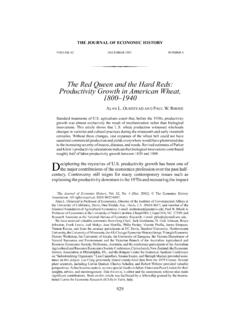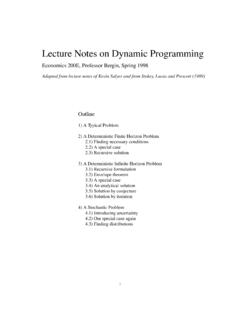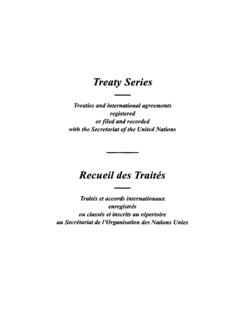Transcription of 2. The British Industrial Revolution, 1760-1860
1 1 ECN 110B, Spring 2005 World Economic History Gregory Clark 2. The British Industrial revolution , 1760-1860 In the eighty years or so after 1780 the population of Britain nearly tripled, the towns of Liverpool and Manchester became gigantic cities, the average income of the population more than doubled, the share of farming fell from just under half to just under one-fifth of the nations output, and the making of textiles and iron moved into the steam-driven factories.
2 So strange were these events that before they happened they were not anticipated, and while they were happening they were not "The whole of nature is unceasingly studied, requested, worked upon, fecundated, husbanded," Marquis de Biencourt, writing of England in 1784. Introduction By 1850, at the apogee of its power, Britain had of world population. The area of the British Isles is only about of the world land mass. Yet Britain then produced two-thirds of world output of coal and one half of world production of cotton textiles and iron.
3 Output per worker was higher in Britain than in any other country. It had enormous colonial possessions including much of India and Pakistan, Canada, Australia, New Zealand, and Ireland. Its navy was the largest in the world, and British defense doctrine called for it to be bigger than the next two largest navies combined. In 1842 it had humiliated the ancient Chinese empire and forced it to cede Hong Kong and to allow the British to ship opium into China. In 1860 the British and French captured Beijing and forced even more humiliating terms on the Britain was so confident of its manufacturing prowess that it pursued an armed policy of forcing free trade on other countries, confident that its manufactures would sweep away protected infant industries in other countries.
4 Thus Britain used a show of force in Persia in 1841 to force it to concede most 1 D. N. McCloskey, "The Industrial revolution in Britain 1780-1860: A Survey," in Roderick Floud and Donald McCloskey, The Economic History of Britain since 1700. 2 It is claimed that by 1855 Chinese tariff policy was firmly under British control, the only restraint on the British being the fear of toppling the current regime by pushing them too far. 2favored nation status. It intervened in Egypt in 1841 out of displeasure with the protectionist With its colonial possessions such as India, Britain in the nineteenth century similarly imposed a policy of strict free trade, even though wages in India were less than one sixth those of Britain by the late nineteenth century.
5 The ascendance of this minor country on the northwest corner of Europe, which in 1700 had a population about one-third that of France (and about 4% that of both China and India) to the position of power it occupied is traditionally seen as being largely the result of the Industrial revolution which occurred in Britain between 1770 and Even within Britain the Industrial revolution changed the balance of power. Up until 1770 the center of population and political power was the south. London had a population of over 500,000 and was the center of Government.
6 The next largest towns in 1760 were Bristol and Norwich, both in the south (see figures 1 and 2). Manchester, the center of the cotton industry had a population of only 17,000. But the Industrial revolution was a phenomenon of the North of the country, and population, income and political power moved in favor of the north. By 1830 Manchester had a population of 180,000, and within 50 miles of Manchester lay most of the cotton textile mills. Thus by 1850 the Manchester area was producing about 40% of the world cotton textile The centers of traditional woolen cloth production in the southwest and around Norwich were replaced by the factory industry in Yorkshire.
7 These areas deindustrialized losing population to the north or to emigration abroad as wages stagnated and unemployment rose. Thus the town of Worcester in the southwest went from 13,000 in 1779 3 The British and French in 1845 intervened in Uruguay in support of a liberal regime that favored freer trade. 4 The dating of the Industrial revolution is largely arbitrary, and the start has been variously given as 1760, 1770 and 1780, while again the end is sometimes given as 1860.
8 5 Liverpool which was the port for Manchester and the cotton textile region similarly grew from 34,000 in 1773 to 78,000 by 1801. 3down to 11,000 by 1801. And Norwich in the south grew by only 1,000 people from 1752 when it had 36,000 to 1801. Three questions arise concerning the Industrial revolution in Britain. The first is "What was it?" At the most basic level of description what happened in Britain in the period 1760 to 1860 that leads it to be regarded as a period of great historical significance? Here we shall see there is a conflict between the traditional views of the Industrial revolution that emphasize the revolutionary nature of the period and modern views that have emphasized that the events of 1760 to 1860 were merely an evolution from what had come before.
9 Remember at the time the Industrial revolution was occurring no-one used that term to describe events: it was introduced by Toynbee in the late nineteenth century. In the same way we do not know yet the term that will be attached to these epoch in the history of the USA. The second question is what was the effect of the Industrial revolution on output per worker? And what was the source of these effects in terms of our growth accounting model? The third question is why did this revolution occur in Britain? Any why did it occur in 1760?
10 In the traditional view four revolutions with completely different natures and mechanisms occurred simultaneously in Britain in the years 1760 to 1860: the Industrial revolution , the (English) Demographic revolution , the Agricultural revolution , and the Transport revolution . We first lay out what the traditional view of what happened in each area is. 4 Figure 1: England in 1800 5 The Industrial revolution In the traditional view this was an unexpected and rapid transformation of key Industrial sectors by mechanical innovations.













